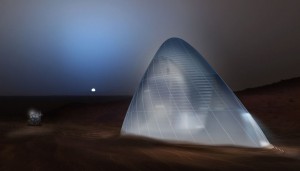By Cutright Elizabeth on March 4, 2016 in News
In the film The Martian, stranded astronaut Mark Watney reflects o n the unique experience of living on Mars.
n the unique experience of living on Mars.
“It’s a strange feeling,” he admits in his video journal. “Everywhere I go, I’m the first. Step outside the rover? First guy ever to be there! Climb a hill? First guy to climb that hills….First, first, first!
“Every day, I go outside and look at the vast horizon,” he later tells his crewmates. “Just because I can.”
The dream of sending explorers, and prospective settlers, to the red planet has captivated us for generations. While getting there is half the battle – taking at least a year in space one way – once our future Martians arrive, they will need sturdy, safe and sustainable lodging. What will real estate on Mars look like?
As part of the effort to think seriously about Mars settlement, NASA recently hosted the 3-D Printed Habitat and Design Competition. Chosen from over 150 submissions, 30 teams presented conceptual designs for 3-D printed Martian habitats.
The winning proposal, Mars Ice House, is a triangular, translucent home constructed of 3-D printed ice that will protect inhabitants from the planet’s radiation while also harnessing natural light and excess oxygen to enable plant cultivation.
“Large windows allow views of the Martian landscape,” promises a promotional video, “giving crew members opportunities to contemplate and reflect, ensuring long-term psychological well-being.”

Talk about an out-of-this-world view! The design looks like a modern igloo in a beehive shape, with rounded walls that will contribute to a feeling of spaciousness. An excellent concept when the planet’s unfriendly environment will require settlers to be inside unless they wear protective spacesuits providing oxygen.
Tasked with creating interplanetary habitats based on “local indigenous materials,” the judges ranked the final designs based on habitability, innovation, functionality and architectural concept. Additionally, the projects also considered where on Mars their structure would be the most successful that would also allow for 3-D print constructability.
With a combined payout of $40,000, Mars Ice House, by Team Space Exploration Architecture and Clouds Architecture Office design, seized the $25,000 top prize, while Team Gamma took second place and a $15,000 award. Team LavaHive rounded out the top three.
The competition is the first step for the 3-D Printed Habitat Challenge, which “seeks to foster the development of new technologies necessary to additively manufacture a habitat using local indigenous materials with, or without, recyclable materials, in space and on Earth.”
“The creativity and depth of the designs we’ve seen have impressed us,” said Centennial Challenges Program Manager Monsi Roman in a NASA Mars house about the competition. “These teams were not only imaginative and artistic with their entries, but they also really took into account the life-dependent functionality our future space explorers will need in an off-Earth habitat.”


